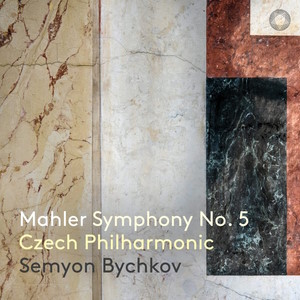
Gustav Mahler (1860-1911)
Symphony No. 5 in C-sharp minor
Czech Philharmonic/Semyon Bychkov
rec. live, 8-11 December, 2021, Dvořák Hall, Rudolfinum, Prague, Czech Republic
PENTATONE PTC5187021 [72]
There are many superb versions of the Fifth symphony which grace the catalogue. Heading the list, in my opinion, is the unforgettable 1987 live recording by Bernstein and the Vienna Philharmonic (review). Among many other splendid accounts are those conducted by Rudolf Barshai and Klaus Tennstedt while I retain a lot of affection for Sir John Barbirolli’s 1968 version (review), through which I first got to know the work.
I reference these other versions – and readers will have their own personal favourites – to indicate the competitive arena into which Semyon Bychkov and the Czech Philharmonic venture with this, the second instalment of their new Mahler cycle for Pentatone. Last year I admired their account of the Fourth symphony (review), so I was keen to hear them take on the next work in the Mahler canon.
A few weeks ago, my colleagues and I listened to Bychkov’s account of the first movement during the most recent of our Listening Studio sessions. We were greatly impressed by both the performance and the recorded sound. Since then I’ve been listening to the complete symphony and those first impressions in the Studio have been reinforced. The first movement gets off to a weighty, imposing start. Bychkov adopts a suitably measured tread: this is a proper and purposeful funeral march and the music exudes tension. When the faster, turbulent section erupts (5:31) the performance is full of drive and passion. This movement, as performed here, is a gripping start to the symphony. The following movement is marked Stürmisch bewegt. Mit großter Vehemenz; no listener could doubt the vehemence in Bychkov’s conception. He and his players dig deep, although the more relaxed passages, the first of which starts at 1:31, are caringly performed. Midway through the movement there’s an extended recitative-like episode for the cello section; this is highly expressive, the pacing very broad. Some might feel that Bychkov takes this episode a bit too broadly but I was seduced by the poetic delivery. It’s one highlight in a rendition that brings out all the emotional contrasts in the movement.
In the great central scherzo, the CPO’s principal horn, Jan Vobořil is in the spotlight. He plays superbly, as do his colleagues in the horn section. This is a captivating performance of the scherzo. In the first few pages the music is delivered as a lovely, lilting dance with the rhythms nicely sprung. Thus, the music is full of life and this proves to be a harbinger of what is to follow. Recently, I’ve been dipping into a box of live performances given by this orchestra in the late 1950s and 1960s under Karel Ančerl. The Czech Philharmonic of today doesn’t have that same distinctive sound but their playing here – and throughout the symphony – is nonetheless full of character; the woodwinds are refreshingly tangy while the strings are marvellously athletic. Mahler makes virtuoso demands on the orchestra in this movement but Bychkov and his players are triumphantly successful in meeting those demands.
The celebrated Adagietto has prompted a wealth of responses from conductors over the years. Some adopt quite a swift tempo – Bruno Walter is probably the exemplar here in his 1947 New York recording which clocks in at 7:38 (review). At the other extreme is Bernstein in his aforementioned 1987 traversal during which the Adagietto plays for 11:13. Bychkov adopts a middle course; his performance takes 9:06. But what matters most is not the timing but the feel of the music. Bychkov leads a tender performance and his conception is greatly enhanced by the gorgeous sound of the CPO’s strings, not forgetting the judiciously balanced harp. Bychkov responds in an ideal fashion when Mahler ramps up the ardour in the music. I found his performance completely persuasive; he lingers just enough to bring out the sense of longing in the music without ever overplaying his hand.
To round off the symphony we hear a celebratory, exuberant account of the Rondo finale. Here, corporate and individual virtuosity is very evident; and rightly so. Mahler treats his rondo material to all manner of variety and Bychkov ensures that all these varieties are experienced and enjoyed by the listener. That’s as it should be, because this is an exercise in compositional virtuosity as well. There’s an abundance of light and shade in the performance and the recording is so expertly balanced – and the performance so expertly conducted by Bychkov – that we hear a myriad of detail. When the brass chorale, first heard towards the end of the second movement, is brought back in all its glory (14:33) it crowns the symphony, as it should. The subsequent presto conclusion is simply exultant.
Semyon Bychkov has the full measure of this score. David Vernon’s absorbing book Beauty and Sadness: Mahler’s 11 Symphonies, which I reviewed last year, describes the spiritual upheavals which Mahler expressed within the pages of the Fifth; I think Bychkov is very successful in bringing out those upheavals. He’s aided by superb playing from the Czech Philharmonic. I love the recording itself. The engineers have provided detailed, clear and natural sound which allows the music to bloom. The resonance as the last chord decays demonstrates how well the music has been captured within the acoustic of the Dvořák Hall.
I was impressed by the first instalment in this new Mahler cycle but this account of the Fifth is, if anything, even finer. This is a distinguished account of the Fifth which whets my appetite for further releases, for which I hope we won’t have to wait too long.
Previous reviews: Ralph Moore (October 2022) ~ David McDade (November 2022)
Help us financially by purchasing from





















